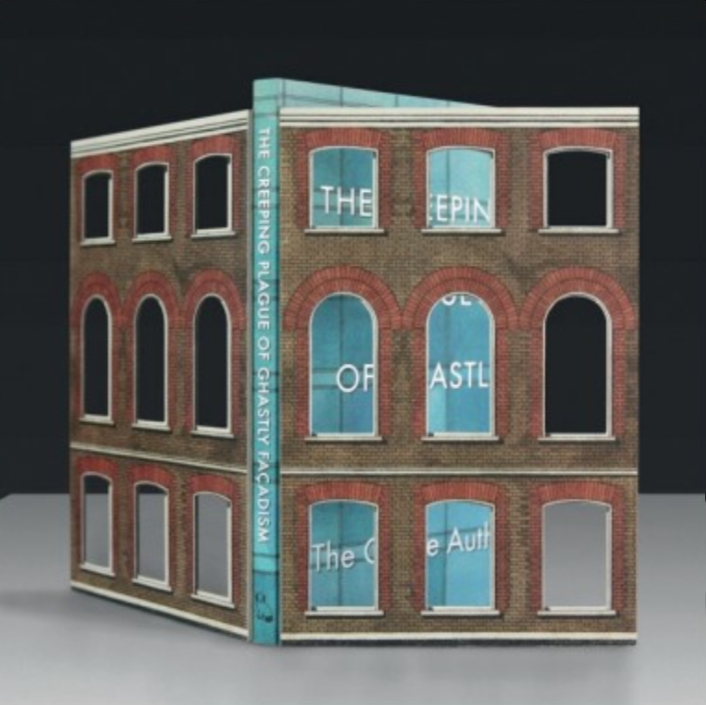The Creeping Plague of Ghastly Facadism

|
| The Creeping Plague of Ghastly Facadism, The Gentle Author, Spitalfields Life Books, 2019, 120 pages, 49 colour illustrations, hardback. |
Since August 2009 the Gentle Author has produced a blog every day of the week about life in Spitalfields. Many of the pieces are profiles of East Enders relating their stories and being introduced to the wider community. From time to time the blog is supplemented by books about the remarkable culture of East London – its history and architecture – which are elegantly designed and illustrated.
The subject of ‘The Creeping Plague of Ghastly Facadism’ first featured in the blog, but the book goes further, highlighting how this disease has spread rapidly across London’s conservation areas in recent times, sometimes even infecting listed buildings. The book begins with the author observing: ‘As if I were being poked repeatedly in the eye with a blunt stick, I can not avoid becoming increasingly aware of a painfully cynical trend in architecture which threatens to turn London into a backlot of an abandoned movie studio’.
He goes on to castigate planning authorities that accept the retention of a historic building’s facade while allowing the rest to be demolished and replaced. Such profligate release of embodied carbon is neither responsible nor sustainable. But, as the author’s photographs demonstrate, the disembodied facades propped up with scaffolding or dominated by grotesque new developments also cause aesthetic harm.
Those who have been in the building conservation profession for some years will recall PPG15, ‘Planning and the Historic Environment’, which was replaced when the less prescriptive National Planning Policy Framework was introduced. In the section dealing with alterations and extensions to listed buildings PPG15 specifically condemned preserving facades while gutting and reconstructing interiors. So why are these hybrid structures now so frequently permitted in London and elsewhere?
The Gentle Author draws attention to the recent wave of development driven by overseas investment, combined with the government’s policy on zero-rating VAT for new construction while taxing renovation and repair of existing buildings. Conservation areas, particularly around the City of London and the West End, have thus become battlegrounds, where developers seeking wholescale redevelopment reach a compromise with councils or the Mayor of London to keep the facade, in the process evading the payment of VAT. Taking note of the current political notion that truth is open to alternative interpretation, the author ironically comments that ‘facadism suits us very well, it is our kind of authenticity’.
Most of the book is taken up with a well-illustrated gazetteer of facadism cases. One was a winner of Building Design’s Carbuncle Cup; another was the former American Embassy, designed by Eero Saarinen and Grade II listed. But the author leaves the most outrageous example to the end: the former Duke of Cambridge in Bethnal Green. This handsome Victorian pub was gutted to create apartments and suffered the indignity of a ‘Reglit’ glass box exploding out through the roof in the most inappropriate manner imaginable.
With an ingenious double-folding cover that satirises the ‘plague’, and other humorous touches, the book makes a compelling case for putting a halt to this epidemic before our streets become mere film sets.
This article originally appeared as ‘Life on a film set’ in Context 168, published by the Institute of Historic Building Conservation (IHBC) in June 2021. It was written by Peter de Figueiredo, reviews editor, Context.
--Institute of Historic Building Conservation
Related articles on Designing Buildings Wiki
IHBC NewsBlog
Images from inside a Grade II listed hotel show the scale of its collapse
The Corbett Arms in Tywyn has fallen into serious disrepair.
Old Sarum fire in listed (& disputed) WW1 Hangar - Wiltshire Council has sought legal advice after fire engulfed a listed First World War hangar that was embroiled in a lengthy planning dispute.
UK Antarctic Heritage Trust launches ‘Virtual Visit’ website area
The Trust calls on people to 'Immerse yourself in our heritage – Making Antarctica Accessible'
Southend Council pledge to force Kursaal owners to maintain building
The Council has pledged to use ‘every tool in the toolbox’ if urgent repairs are not carried out.
HE’s Research Magazine publishes a major study of the heritage of England’s suburbs
The article traces the long evolution of an internal programme to research 200 years of suburban growth
IHBC Context 183 Wellbeing and Heritage published
The issue explores issues at the intersection of heritage and wellbeing.
SAVE celebrates 50 years of campaigning 1975-2025
SAVE Britain’s Heritage has announced events across the country to celebrate bringing new life to remarkable buildings.
IHBC Annual School 2025 - Shrewsbury 12-14 June
Themed Heritage in Context – Value: Plan: Change, join in-person or online.
200th Anniversary Celebration of the Modern Railway Planned
The Stockton & Darlington Railway opened on September 27, 1825.
Competence Framework Launched for Sustainability in the Built Environment
The Construction Industry Council (CIC) and the Edge have jointly published the framework.














